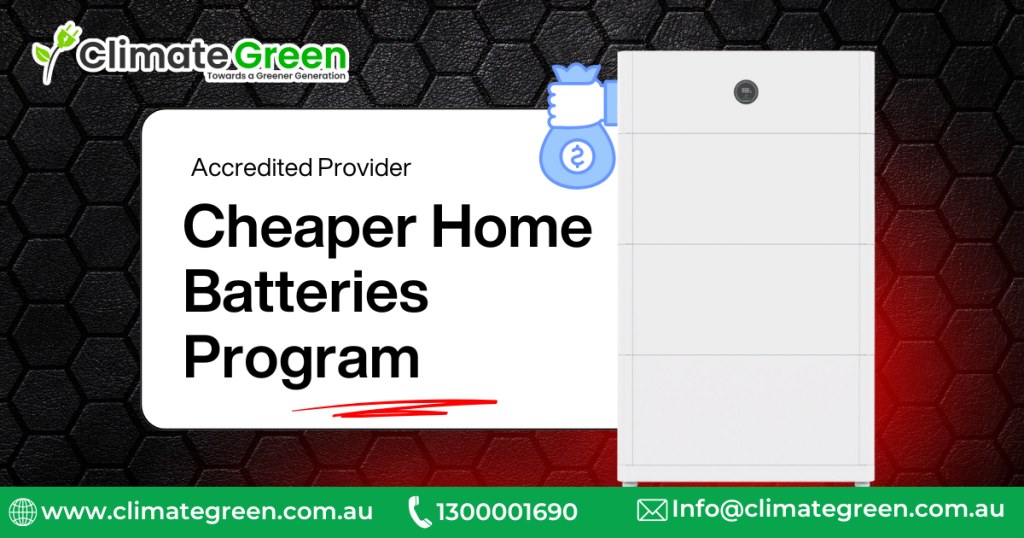Cheaper Home Batteries Program
Australia’s energy future is becoming brighter — and more affordable — thanks to the Federal Government’s Cheaper Home Batteries Program. From July 2025, homeowners, businesses, and community groups across Victoria can access generous rebates on solar battery installations.
At Climate Green Melbourne, we’re here to help you understand how much you can save, what’s required to qualify, and why now is the best time to invest in a battery system.
What Is the Cheaper Home Batteries Program?
The Cheaper Home Batteries Program is a new national initiative designed to make home energy storage systems more affordable. Delivered under the Small-scale Renewable Energy Scheme (SRES), it provides upfront discounts on approved solar batteries when installed with rooftop solar.
Instead of waiting for rebates later, the program applies savings directly at the point of installation, reducing your out-of-pocket cost immediately.
How Much Is the Federal Battery Rebate Worth in 2025?
In 2025, the rebate is set at ~$372 per kWh of battery capacity, capped at 50 kWh per system.
That’s up to $18,500 in rebates per installation — instantly lowering your costs.
Here’s an idea of what that looks like in practice:
| Battery Size (Usable Capacity) | Typical Installed Cost | Rebate (Approx. 30%) | Net Cost After Rebate |
|---|---|---|---|
| 5 kWh | $3,000 – $8,000 | $900 – $2,400 | $2,100 – $5,600 |
| 10 kWh | $7,000 – $16,000 | $2,100 – $4,800 | $4,900 – $11,200 |
| 13.5 kWh | $10,000 – $20,000 | $3,000 – $6,000 | $7,000 – $14,000 |
| 20 kWh | $20,000 – $34,000 | $6,000 – $10,200 | $14,000 – $23,800 |
The sooner you install, the better. The rebate will step down every year until 2030, as battery costs continue to fall.
Eligibility Criteria
To access the rebate in Victoria, households must:
- Install an eligible battery sized 5–50 kWh (or upgrade an existing system to ≤100 kWh).
- Have solar PV installed — the battery must be connected to rooftop solar, not just the grid.
- Use VPP-capable hardware — for grid-connected systems, the battery must be capable of joining a Virtual Power Plant (joining is optional).
- Choose approved products & installers — batteries must be on the Clean Energy Council’s approved list and installed by accredited professionals.
- Permanent installation — portable batteries or EV batteries do not qualify.
There is no income means test. Both homeowners and investors can benefit, and the federal rebate can be stacked with other Victorian solar rebates (such as the state’s solar panel rebate of up to $1,400).
Why Add a Battery to Your Solar System?
A solar battery is more than just a way to store excess solar energy. For Victorians, it’s the key to lower bills, energy independence, and future-proofing your home.
Benefits include:
- Lower Bills – Use stored solar energy in the evenings instead of buying from the grid.
- Peak Savings – Avoid costly peak-time rates by relying on yesterday’s sunshine.
- Maximum Solar Self-Use – Store excess daytime solar that would otherwise be exported at low feed-in tariffs.
- Backup Power – Many batteries provide power during outages, keeping essentials running.
- Greener Living – Reduce your reliance on fossil fuels and cut your carbon footprint.
- VPP Readiness – Join Virtual Power Plants in the future for extra income opportunities.
How Much Will Solar + Battery Cost After Rebates?
When combined, federal STCs for solar panels and the solar battery rebate can reduce the cost of a solar + battery package by tens of thousands.
For example:
- A 6.6kW solar system already costs as little as $4,500–$6,500 after rebates.
- Adding a 10 kWh battery with the new rebate brings the total system cost down to around $10,000–$12,000 (instead of $16,000+).
This makes it easier for households to achieve near energy independence — slashing grid bills and protecting against rising electricity prices.
Final Thoughts
The Federal Government’s Cheaper Home Batteries Program is a game-changer for Melbourne households. By covering around 30% of battery system costs upfront, it makes energy storage more affordable than ever.
But the rebate value declines every year until 2030, so acting in 2025 ensures you maximise your savings.
At Climate Green Melbourne, we are an accredited provider under the program. We’ll take care of the rebates, compliance, and installation — making your transition to solar + battery seamless and stress-free.
Call us today: 1300 001 690
Email: info@climategreen.com.au
Switch to cheaper, cleaner, and smarter energy with Climate Green Melbourne.
1. How much is the federal solar battery rebate in 2025?
The rebate is worth around $372 per kWh of battery capacity, capped at 50 kWh. That means you can save up to $18,500 on a new battery system.
2. Who is eligible for the rebate in Victoria?
Any household, small business, or community group installing a 5–50 kWh battery with solar PV qualifies. Both homeowners and investors can apply, and there’s no income test.
3. Do I need solar panels to claim the rebate?
Yes. The battery must be connected to a rooftop solar system (new or existing). Standalone batteries that only charge from the grid are not eligible.
4. Can I combine this rebate with Victorian solar incentives?
Yes. You can stack the federal battery rebate with other programs like the Victorian Solar Homes rebate (up to $1,400 for panels). This significantly reduces upfront costs.
5. What does VPP-capable mean?
Your battery and inverter must be able to connect to a Virtual Power Plant (VPP) if required in the future. Joining a VPP is optional, but the hardware must be compatible.
6. How much will a 10 kWh solar battery cost after the rebate?
A 10 kWh battery system that normally costs $7,000–$16,000 will drop to about $4,900–$11,200 after the rebate.
7. Is there a deadline for the program?
The rebate steps down in value each year until 2030. Installing in 2025 locks in the highest rebate rate.


